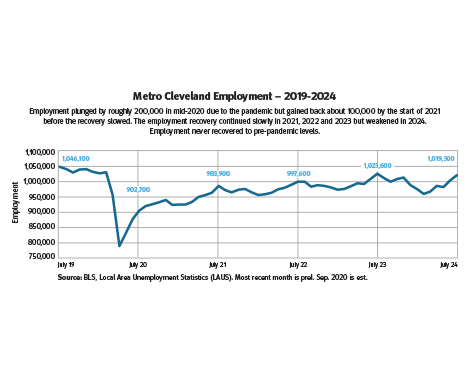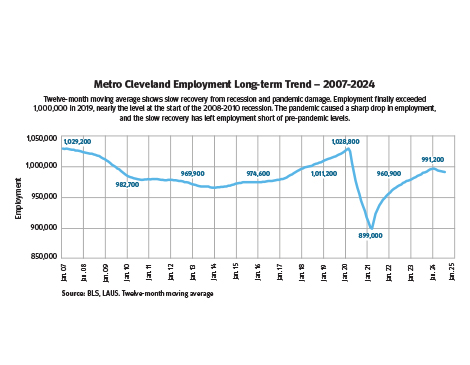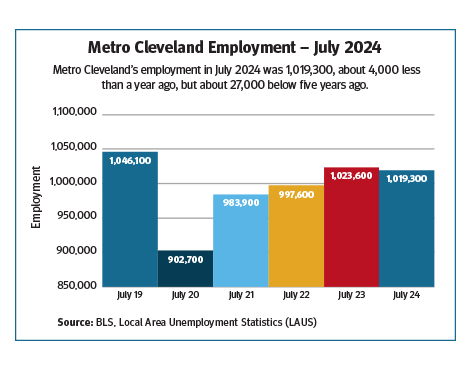A slowing in jobs growth and an erratic stock market are both raising concerns about our national economy. The unreported news from Metropolitan Cleveland is that employment began to slow down in late 2023. After three years of moderate but consistent post-COVID employment growth, the number of jobs contracted in the first half of 2024. This suggests that Metro Cleveland may be facing rough economic conditions.
The Bureau of Labor Statistics (BLS) has data from household surveys that document the change and provide a context for understanding past and current conditions in Metro Cleveland. BLS’s Local Area Unemployment Statistics (LAUS) show that employment in the five-county local area (Cuyahoga, Geauga, Lake, Lorain and Medina counties) dropped by over 140,000 from July 2019 to July 2020 due to COVID. It rebounded by over 80,000 by July 2021 and gradually improved by 15,000-20,000 per year until 2023. Unfortunately, local employment never reached the pre-pandemic level.

There was a significant change in the first half of 2024: Employment contracted at an annual rate of over -9,000 (-1%). At the same time, unemployment began to increase. The reversal in employment-unemployment is an indicator of possible economic challenges.
The contraction is the delayed result of the convergence of a number of unusual post-COVID conditions. Government COVID payments, prolonged unemployment payments, special industry subsidies and an expansion of consumer credit supported a narrow economic recovery for consumers, but not a normal recovery of economically productive retail, manufacturing or technological activities, which could have sustained a longer expansion.
As time went on, excessive government spending and consumer credit growth fueled inflation. Consumers faced higher costs for gas and energy, food and housing, which affected consumer demand. At the same time, there was an increase of remote work, an explosion of online retail activity and changing consumer tastes. These factors reduced consumer demand for existing businesses.
Several societal factors affecting business decision-making may also increase the potential for problems. There is widespread economic uncertainty about business fundamentals such as tax and regulatory policies, energy costs, potential supply chain disruptions and the international environment.
Businesses have found it difficult to hire employees with adequate skills, education and good work habits. Remote workers and a changed work environment are more challenging for businesses to manage. The result is that businesses are more likely to seek a long-term technological solution than to rely on hiring additional employees.

With the combination of local and national factors working against the area’s economy, it is hard to be optimistic about Metro Cleveland’s employment future. The area lost over 40,000 jobs in the severe 2008-2010 recession, and it took nearly 10 years, until 2019, to gain them back. The potential for an areawide employment contraction is real. Political and community leaders would be wise to prepare for economic challenges and to foster a positive entrepreneurial climate to encourage a strong employment rebound.
James M. Trutko is an economist, market research professional and public policy analyst. He has held positions with The Plain Dealer and Greater Cleveland Growth Association. He writes articles for local publications and counsels entrepreneurs with Business Advisers of Cleveland. He can be reached at jmtrutko@gmail.com. More data on individual industry performance is available at his website, cuyahogascoreboard.com.




